Book contents
- Frontmatter
- Contents
- Preface
- PART I SURVEY ARTICLES
- PART II RESEARCH PAPERS
- Ergodic baker's transformations
- Almost sure convergence of projections to self-adjoint operators in L2(0,1)
- Quasi-uniform limits of uniformly recurrent points
- Strictly nonpointwise Markov operators and weak mixing
- Two techniques in multiple recurrence
- For Bernoulli transformations the smallest natural family of factors consists of all factors
- Topological entropy of extensions
- Functional equations associated with the spectral properties of compact group extensions
- Multiple recurrence for nilpotent groups of affine transformations of the 2-torus
- A remark on isometric extensions in relatively independent joinings
- Three results in recurrence
- Calculation of the limit in the return times theorem for Dunford-Schwartz operators
- Eigenfunctions of T x S and the Conze-Lesigne algebra
- Conference Program
- List of Participants
Strictly nonpointwise Markov operators and weak mixing
Published online by Cambridge University Press: 24 February 2010
- Frontmatter
- Contents
- Preface
- PART I SURVEY ARTICLES
- PART II RESEARCH PAPERS
- Ergodic baker's transformations
- Almost sure convergence of projections to self-adjoint operators in L2(0,1)
- Quasi-uniform limits of uniformly recurrent points
- Strictly nonpointwise Markov operators and weak mixing
- Two techniques in multiple recurrence
- For Bernoulli transformations the smallest natural family of factors consists of all factors
- Topological entropy of extensions
- Functional equations associated with the spectral properties of compact group extensions
- Multiple recurrence for nilpotent groups of affine transformations of the 2-torus
- A remark on isometric extensions in relatively independent joinings
- Three results in recurrence
- Calculation of the limit in the return times theorem for Dunford-Schwartz operators
- Eigenfunctions of T x S and the Conze-Lesigne algebra
- Conference Program
- List of Participants
Summary
Abstract. Strictly nonpointwise Markov operators are those which admit no nontrivial pointwise factors. The asymptotic set-system which is responsible for the pointwise factors is then weakly mixing. Examples of nontrivial behavior in this case are given.
INTRODUCTION
Many results proved for Markov operators, especially for their asymptotic behavior, are generalizations of analogous results obtained formerly for topological dynamical systems (see e.g. [Downarowicz–Iwanik, 1988], [Jamison–Sine, 1969], [Lotz, 1968]). A way of extending these results is by viewing the operator as a pointwise transformation on some compact space (the space of probability measures, the space of trajectories, etc.). Sometimes, however, this analogy fails to work. For example, the multiple recurrence theorem for n commuting operators has only been proved in the case of n = 2, since the passage to the space of trajectories used in the proof is not possible in higher dimensions [Downarowicz–Iwanik, 1988].
In order to better understand the nature of Markov operators in distinction from topological dynamical systems, this note is devoted to selecting and investigating operators whose behavior has as little in common with a pointwise transformation as possible. For most of the time, we will concentrate on the case of a minimal (irreducible) action of the operator. In Section 1, we introduce the definition of strictly nonpointwise Markov operators and derive a basic spectral property. Section 2 contains preliminaries for further deductions. In Section 3, the notion of the asymptotic set-system associated with a Markov operator is introduced, the carrier of the pointwise type behavior that still remains.
- Type
- Chapter
- Information
- Ergodic Theory and Harmonic AnalysisProceedings of the 1993 Alexandria Conference, pp. 259 - 272Publisher: Cambridge University PressPrint publication year: 1995



